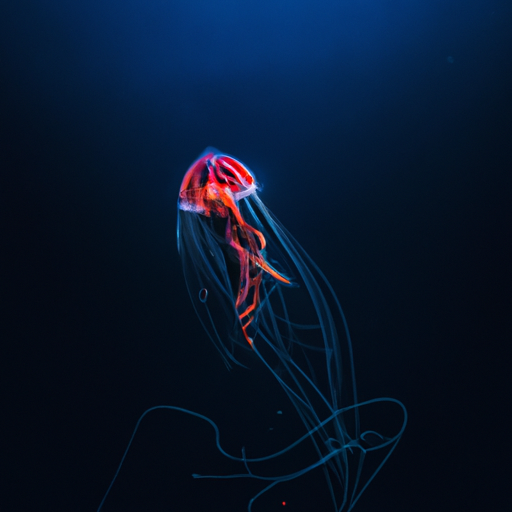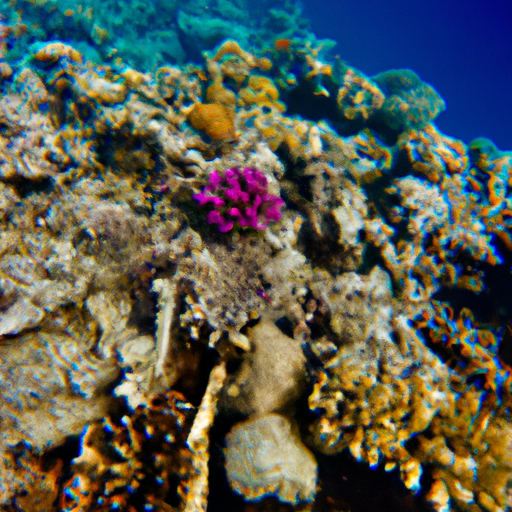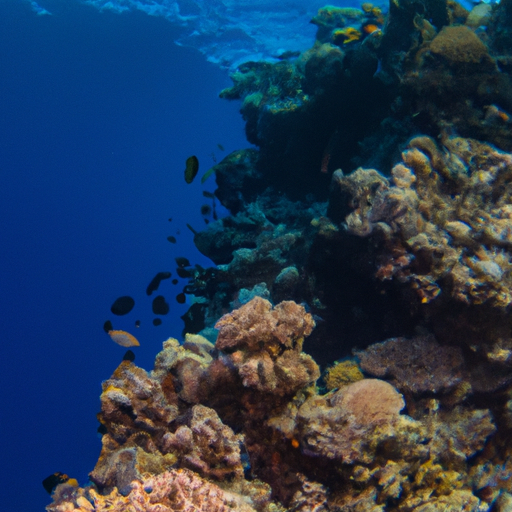
The Depths of Survival: How Marine Life Thrives in the Deep Blue Sea
The deep blue sea is a mysterious and challenging environment for marine life. With extreme pressures, complete darkness, and limited resources, survival in the deep sea requires extraordinary adaptations. In this article, we will explore the fascinating ways in which marine life thrives in the depths of the ocean.
One of the most remarkable adaptations of deep-sea creatures is their ability to withstand the immense pressure of the ocean. In the depths, the pressure can reach several hundred times that of the surface. To survive, many species have evolved with strong, flexible bodies that can resist the crushing force of the water. Some deep-sea fish, for example, have gelatinous bodies that allow them to compress under pressure without being damaged.
In addition to pressure, darkness is another challenge that marine life faces in the deep sea. Without sunlight to support photosynthesis, organisms have had to find alternative ways to obtain energy. Many rely on chemosynthesis, a process in which bacteria convert chemicals, such as methane or hydrogen sulfide, into energy. This adaptation allows deep-sea organisms to thrive in areas where no other life forms can survive.
Another intriguing adaptation of deep-sea creatures is their remarkable ability to reproduce and find mates in a vast, dark environment. Many species have developed specialized sensory organs and bioluminescent displays to communicate and attract potential partners. Some deep-sea fish, for example, have photophores – light-producing organs – that they use to create mesmerizing displays and lure prey or potential mates.
Furthermore, the limited availability of food in the deep sea has led many organisms to become highly efficient and opportunistic feeders. Some deep-sea fish have elongated jaws and expandable stomachs, allowing them to consume prey larger than themselves. Others have evolved to have sharp, needle-like teeth to snatch unsuspecting prey in the darkness.
Overall, the adaptations of deep-sea creatures to survive and thrive in the harsh conditions of the deep blue sea are truly fascinating. From their ability to withstand immense pressure to their reliance on chemosynthesis for energy, these creatures have developed ingenious strategies to conquer the challenges of their environment. Studying and understanding these adaptations not only sheds light on the wonders of marine life but also provides valuable insights for future exploration and conservation efforts.
Adapting to the Unknown: Exploring the Fascinating Ways Marine Creatures Survive
The deep blue sea is a mysterious and largely unexplored world, teeming with a wide array of marine life. In order to survive and thrive in this inhospitable environment, marine creatures have developed fascinating adaptations that allow them to overcome the challenges they face. From the darkest depths to the sunlit surface, these adaptations enable marine organisms to navigate, hunt for food, avoid predators, and reproduce. This article explores some of the most intriguing adaptations of marine life.
One of the most remarkable adaptations is bioluminescence, which is the ability of some marine organisms to produce light. This adaptation serves multiple purposes, including communication, attracting prey, and deterring predators. Deep-sea creatures such as the anglerfish use bioluminescent lures to attract unsuspecting prey, while others like the firefly squid create mesmerizing displays to communicate and find mates in the dark depths.
Another fascinating adaptation is camouflage, which allows marine organisms to blend in with their surroundings and remain hidden from predators or prey. The octopus, for example, is a master of disguise, capable of changing its skin color and texture to mimic its environment. From imitating coral reefs to resembling rocks, the octopus can effectively disappear from sight and ambush unsuspecting prey or avoid becoming a meal itself.
Surviving in the deep sea also requires adaptations to withstand extreme pressures, frigid temperatures, and limited food sources. Some deep-sea fish have developed flexible bodies and gelatinous tissues that allow them to withstand the immense pressure at great depths. Others have evolved specialized enzymes and proteins that enable them to survive in freezing temperatures. Additionally, many deep-sea creatures have slow metabolisms and can go for long periods without eating, relying on sporadic food sources that fall from the surface.
Furthermore, the ability to navigate and orient themselves in the vast ocean is crucial for many marine organisms. They rely on a variety of adaptations such as magnetic sensing, celestial navigation, and even sonar-like abilities to find their way. Some species of sea turtles, for instance, can navigate vast distances using the Earth’s magnetic field as a compass, while dolphins and whales use echolocation to locate food and communicate with each other.
In conclusion, the adaptations of marine life are truly fascinating, allowing these organisms to not only survive, but thrive in the deep blue sea. From bioluminescence and camouflage to adaptations for extreme conditions and navigation, marine creatures have developed an impressive array of skills to conquer the challenges of their environment. Studying these adaptations not only reveals the wonders of the marine world but also provides valuable insights into the potential for adaptation and survival in our ever-changing planet.
From Darkness to Light: The Incredible Adaptations of Deep-Sea Environments
The deep-sea environment is one of the most extreme and challenging habitats on Earth. With its total darkness, freezing temperatures, and crushing pressures, surviving in this environment requires incredible adaptations. Yet, despite these harsh conditions, marine life in the deep blue sea has managed to not only survive but thrive. In this article, we will explore some of the fascinating adaptations that enable these organisms to navigate and flourish in the depths.
One of the most remarkable adaptations of deep-sea creatures is their ability to withstand high pressure. As you descend further into the ocean, the pressure increases exponentially. For every 10 meters, the pressure goes up by around 1 atmosphere, or 14.7 pounds per square inch. To withstand these pressures, deep-sea organisms have developed unique structures such as thick, flexible cell walls or skeletons that can resist crushing. Some species also possess gas-filled chambers within their bodies to maintain buoyancy.
Another crucial adaptation found in deep-sea organisms is their ability to survive in complete darkness. With no sunlight reaching these depths, organisms have had to rely on alternative sources of energy. Many deep-sea creatures have evolved bioluminescence, the ability to produce light. This adaptation serves various purposes, from attracting prey or mates to camouflage or communication. The ability to produce light has undoubtedly given these organisms a significant advantage in the deep-sea ecosystem.
The lack of sunlight also affects the way deep-sea organisms reproduce and find food. Unlike their shallow-water counterparts, deep-sea marine life cannot rely on photosynthesis for food production. Instead, they have adapted to survive on a diet of detritus and the occasional organic material that falls from the surface. Some species have even developed unique feeding mechanisms, such as filter-feeding appendages or elongated jaws that can capture prey in the darkness.
Surviving in the deep-sea environment also requires adaptations to extreme cold temperatures. The average temperature in the deep ocean is around 4 degrees Celsius (39.2 degrees Fahrenheit). To cope with these frigid conditions, deep-sea organisms often have higher levels of unsaturated fatty acids in their cell membranes, allowing them to remain fluid and flexible in cold water. Some species even produce antifreeze proteins to prevent ice crystal formation within their cells.
In conclusion, the adaptations of marine life in the deep-sea environment are truly awe-inspiring. From withstanding intense pressures to navigating in complete darkness and surviving extreme cold temperatures, these organisms have developed remarkable strategies to thrive in the deep blue sea. The study of these adaptations not only enhances our understanding of the deep-sea ecosystem but also serves as a reminder of the incredible ingenuity of life on Earth.
Unveiling the Secrets of the Deep: The Extraordinary Abilities of Marine Life
Marine life is a testament to the incredible adaptability of nature. The deep blue sea, with its immense pressure, pitch darkness, and extreme temperatures, presents a challenging environment for any organism. Yet, thousands of species have not only managed to survive but also thrive in these conditions, thanks to their remarkable adaptations.
One of the most fascinating adaptations of marine life is bioluminescence. Many organisms, including certain species of fish, jellyfish, and plankton, have the ability to produce and emit light. This adaptation serves various purposes, such as attracting prey, communicating with others of their kind, or even disguising themselves from predators. The deep sea, which lacks sunlight, becomes an enchanting world of glowing organisms, creating a mesmerizing spectacle.
Another extraordinary adaptation found in marine life is their ability to withstand extreme pressure. In the deep sea, the pressure can reach thousands of pounds per square inch, far greater than what humans can tolerate. Certain fish species, such as the Mariana snailfish, have bodies that are specifically designed to withstand such immense pressure. Their bodies contain flexible bones and tough skin, allowing them to navigate effortlessly through the depths without being crushed by the weight of the water.
Marine life has also developed unique ways to cope with the scarcity of food in the deep sea. One example is the anglerfish, which has a bioluminescent lure dangling from its head. This lure attracts unsuspecting prey, ensnaring them in the anglerfish’s sharp teeth. Additionally, many deep-sea organisms have elongated jaws and expandable stomachs, allowing them to consume larger prey when it becomes available, thus maximizing their chances of survival in a challenging environment.
Temperature is another major factor in the deep sea, with water temperatures often near freezing. Yet, numerous marine organisms have adapted to thrive in these frigid conditions. Some species of fish, for instance, produce antifreeze proteins that prevent ice crystals from forming within their bodies, allowing them to remain functional in sub-zero temperatures. Other organisms have developed specialized metabolisms that can efficiently convert limited food resources into energy, enabling them to sustain themselves in the cold, nutrient-poor waters of the deep sea.
As our understanding of the deep sea continues to expand, we are constantly awe-struck by the extraordinary abilities of marine life. These adaptations not only allow them to survive in one of the most extreme environments on Earth but also provide invaluable insights into the resilience and ingenuity of nature. Unveiling the secrets of the deep sea and its inhabitants is a journey that promises to uncover even more remarkable adaptations and marvels of adaptation.


